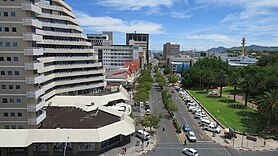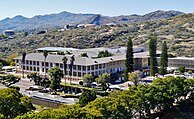
Back Виндхук ADY Windhoek Afrikaans ዊንድሁክ Amharic Windhoek AN ويندهوك Arabic ڤيندهوك ARY ويندهوك ARZ Windḥoek AST Windhoek AVK Vindhuk Azerbaijani
Windhoek
| |
|---|---|
| City of Windhoek | |
Clockwise from top: Windhoek CBD, Parliament building, Windhoek railway station, State House, Christ Church | |
| Motto: Suum Cuique (Latin for 'To each his own') | |
Location of Windhoek in Namibia | |
| Coordinates: 22°34′12″S 17°5′1″E / 22.57000°S 17.08361°E | |
| Country | |
| Region | Khomas Region |
| First settled | 1840 |
| Second founding | 18 October 1890 |
| Government | |
| • Type | Mayor-council government |
| • Mayor | Queen Kamati (SWAPO) |
| • Deputy Mayor | Joseph Uapingene (NUDO) |
| Area | |
| • Total | 5,133 km2 (1,982 sq mi) |
| Elevation | 1,655 m (5,430 ft) |
| Population (2023 census)[1] | |
| • Total | 486,169 |
| • Density | 95/km2 (250/sq mi) |
| Time zone | UTC+02:00 (Central Africa Time) |
| • Summer (DST) | (Not Observed) |
| Postal code | 10005 |
| Area code | 061 |
| Climate | BSh |
| Website | www |
Windhoek (/ˈwɪndhʊk/, Afrikaans: [ˈvəntɦuk] ; German: Windhuk [ˈvɪnthʊk] ; Khoekhoe: ǀAi-ǁGams; Otjiherero: Otjomuise) is the capital and largest city of Namibia. It is located in central Namibia in the Khomas Highland plateau area, at around 1,700 m (5,600 ft) above sea level, almost exactly at the country's geographical centre. The population of Windhoek, which was 486,169 in 2023,[2] is constantly growing due to a continued migration from other regions in Namibia.
Windhoek is the social, economic, political, and cultural centre of the country. Nearly every Namibian national enterprise, governmental body, educational and cultural institution is headquartered there.
The city developed at the site of a permanent hot spring known to the local pastoral tribes. It developed rapidly after Jonker Afrikaner, Captain of the Orlam, settled there in 1840 and built a stone church for his community. In the decades following, multiple wars and armed hostilities resulted in the neglect and destruction of the new settlement. Windhoek was founded a second time in 1890 by Imperial German Army Major Curt von François, when the territory was colonised by the German Empire.
- ^ "2023 Population & Housing Census Preliminary Report" (PDF). Statistics Namibia. Archived from the original (PDF) on 24 March 2024. Retrieved 16 March 2024.
- ^ "Namibia: Regions, Towns, Villages & Settlements - Population Statistics, Maps, Charts, Weather and Web Information". www.citypopulation.de. Retrieved 16 March 2024.








